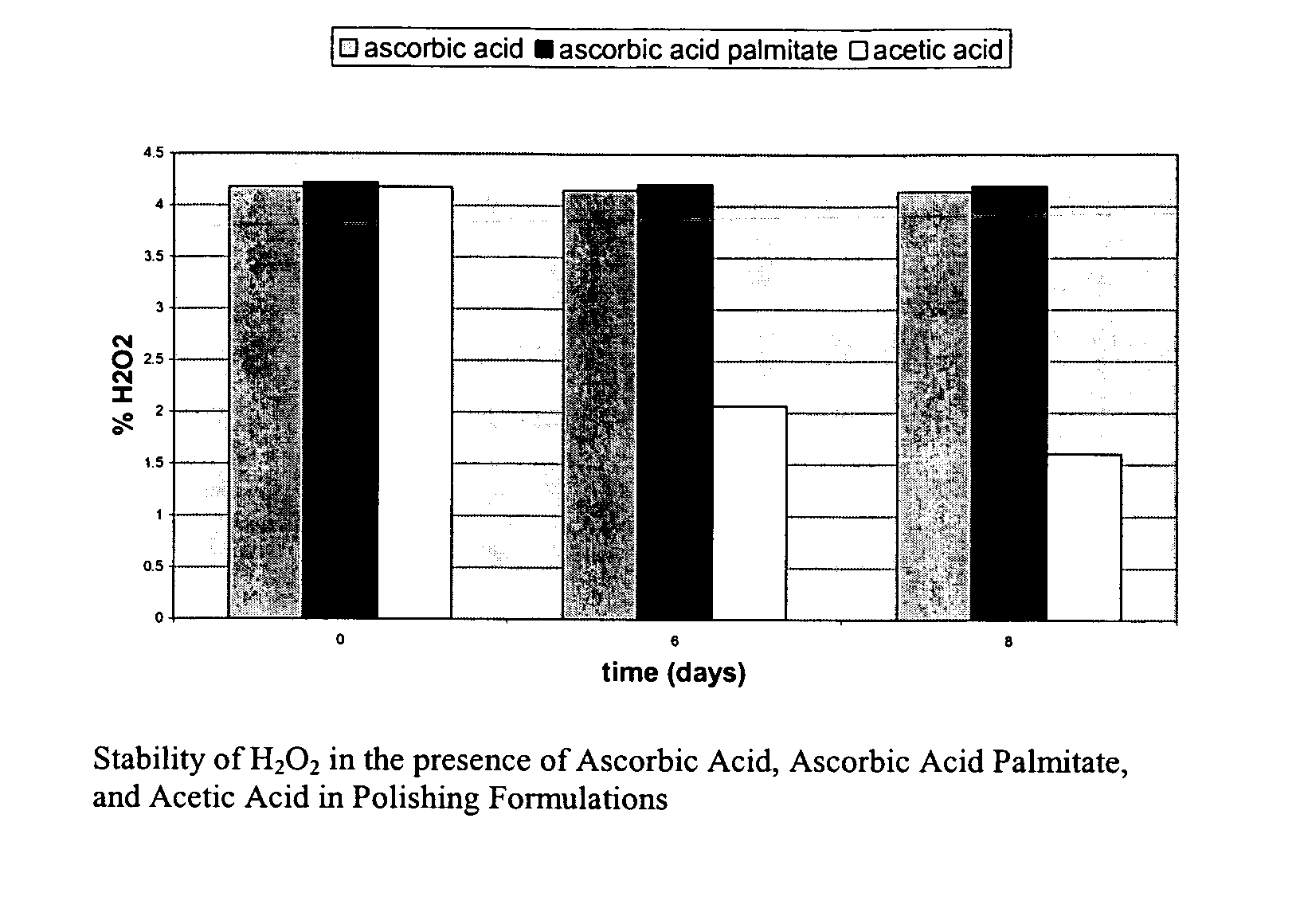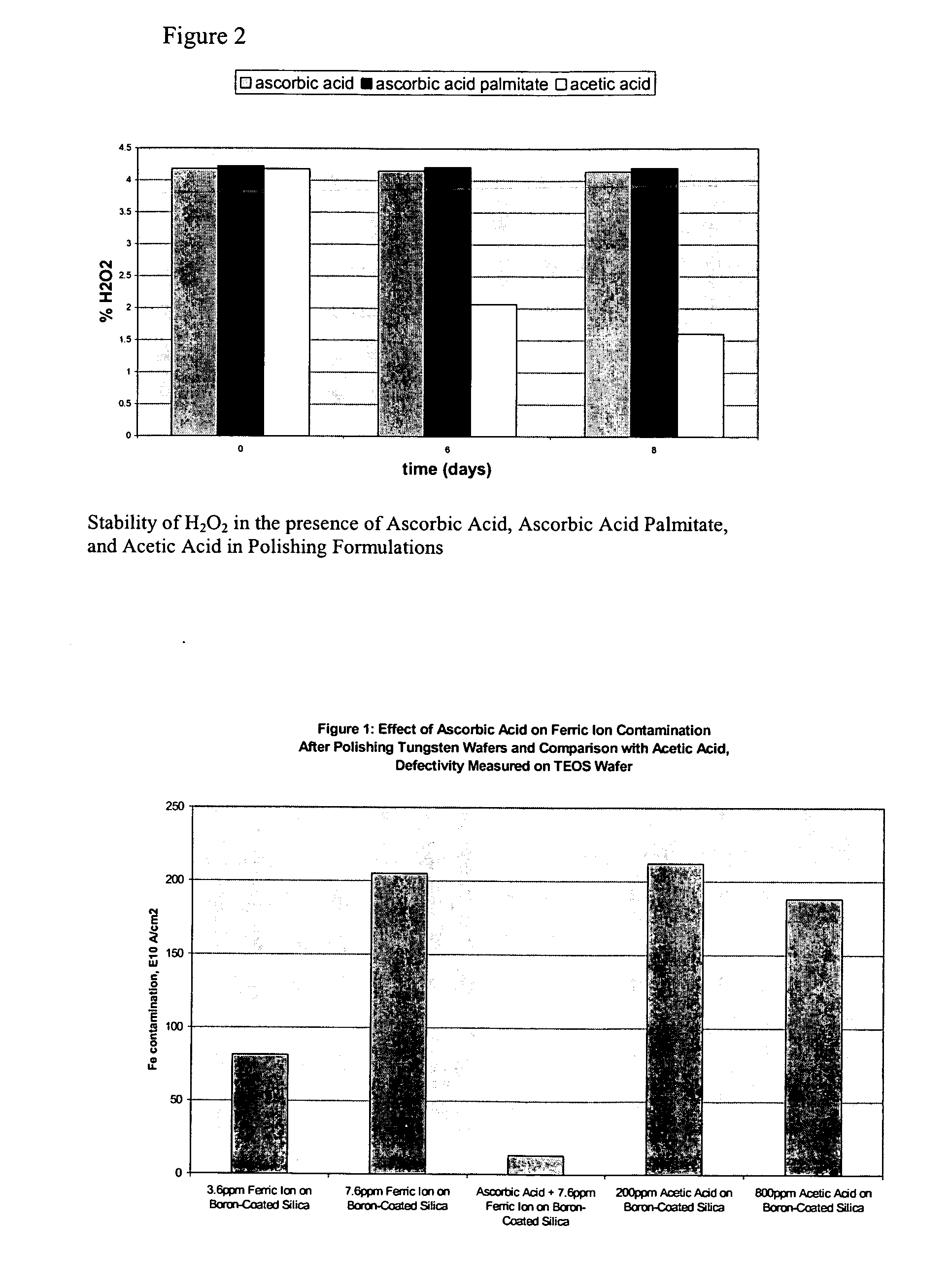Dihydroxy enol compounds used in chemical mechanical polishing compositions having metal ion oxidizers
a technology of dihydroxy enol compounds and metal ion oxidizers, which is applied in the direction of polishing compositions with abrasives, other chemical processes, chemistry apparatuses and processes, etc., can solve the problems of no longer using the approach, increasing the handling difficulty, and high defectivity of the wafer, so as to improve the polishing rate and the polishing rate. , the effect of improving the polishing ra
- Summary
- Abstract
- Description
- Claims
- Application Information
AI Technical Summary
Benefits of technology
Problems solved by technology
Method used
Image
Examples
example 3
[0151] Tungsten and titanium nitride removal rates at time zero; 200 ppm Ascorbic acid added, substantially no soluble metal oxidizers present.
[0152] In Example 3, the formulation was same as Example 2, the only difference being the addition of 200 ppm of ascorbic acid at the last step during the preparation of the polishing formulation. Polishing experiments were conducted at time zero as done for the control in Example 1. The substrate was effectively planarized using the above polishing composition under the stated conditions in Example 2. The tungsten removal rates, titanium nitride removal rates, PETEOS removal rates, selectivity of tungsten to titanium nitride, and selectivity of tungsten to PETEOS are shown in Table 1 (Example 3.)
[0153] The iron-modified-boron-modified silica was found to retain most of the bound iron ions, and therefore there was very little soluble iron in solution.
example 17
[0178] This example shows how a modest amount of ascorbic acid can remove tightly bound metal ions from the surface of silica (a dielectric). An aqueous composition was prepared having 1.4% of an acid stabilized 180nm average particle size colloidal silica and 1.4% of a 50nm average particle size iron-surface-modified colloidal silica. The level of iron on the iron-surface-modified colloidal silica was sufficient to provide ppm Fe in the slurry. Then, 2400 ppm of ascorbic acid was added and the material was allowed to age a few days. Surprisingly, the ascorbic acid removed most of the bound iron from the silica surface. The Fe in supernatant was 166 ppm, while the total Fe in the system (from aqua regia digestion) was 181 ppm. In contrast, similar experiments with boron-iron-surface-modified colloidal silica showed almost zero removal of iron from the boron-modified surface of the silica.
example 18
[0179] A CMP composition was prepared using a composition much as was described in Example 17, but to make the CMP composition on part of the the Example 17 concentrate was diluted by 5 parts of water and 0.1 parts of aqueous hydrogen peroxide. Surprisingly, metal removal rates were near the rates expected from using the iron-surface-modified slurry such as was used to prepare Example 17, but without adding ascorbic acid. While at least 80% of the available iron was in soluble form, the metal removal rates did not drop as much as would be expected from adding an equivalent amount of totally soluble iron to a similar slurry not having iron-surface-modified abrasive, much less the large drop in metal removal rate expected for an equivalent amount of totally soluble iron to a similar slurry not having iron-surface-modified abrasive and a peroxide “stabilizer” as taught in the prior art.
PUM
| Property | Measurement | Unit |
|---|---|---|
| particle diameters | aaaaa | aaaaa |
| particle diameters | aaaaa | aaaaa |
| particle diameters | aaaaa | aaaaa |
Abstract
Description
Claims
Application Information
 Login to View More
Login to View More - R&D
- Intellectual Property
- Life Sciences
- Materials
- Tech Scout
- Unparalleled Data Quality
- Higher Quality Content
- 60% Fewer Hallucinations
Browse by: Latest US Patents, China's latest patents, Technical Efficacy Thesaurus, Application Domain, Technology Topic, Popular Technical Reports.
© 2025 PatSnap. All rights reserved.Legal|Privacy policy|Modern Slavery Act Transparency Statement|Sitemap|About US| Contact US: help@patsnap.com



